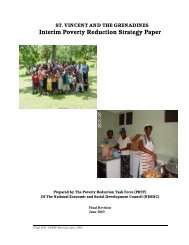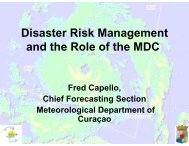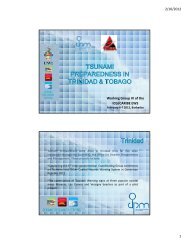The Anatomy of A Silent Crisis The Anatomy of A Silent Crisis
The Anatomy of A Silent Crisis The Anatomy of A Silent Crisis
The Anatomy of A Silent Crisis The Anatomy of A Silent Crisis
- TAGS
- anatomy
- www.bb.undp.org
You also want an ePaper? Increase the reach of your titles
YUMPU automatically turns print PDFs into web optimized ePapers that Google loves.
104 Forum 2009: Climate Change – <strong>The</strong> <strong>Anatomy</strong> <strong>of</strong> a <strong>Silent</strong> <strong>Crisis</strong><br />
120. Updated Water Stress calculation conducted for<br />
Global Humanitarian Forum Report 2009 by Gerten,<br />
D. and Heinke, J.<strong>of</strong> PIK Research Portal.<br />
121. Kundzewicz, Z.W., et al. (2007): “Freshwater<br />
resources and their management.” Climate<br />
Change 2007: Impacts, Adaptation and Vulnerability,<br />
Contribution <strong>of</strong> Working Group II to the Fourth<br />
Assessment Report <strong>of</strong> the Intergovernmental Panel on<br />
Climate Change, M.L. Parry, et al. Eds., Cambridge<br />
University Press, Cambridge, UK, 173-210, p 194<br />
and Hinrichsen, D., Robey, B., and Upadhyay,<br />
U.D. (1997): “Solutions for a Water-Short World.”<br />
Population Reports, Series M, No. 14. Baltimore,<br />
Johns Hopkins School <strong>of</strong> Public Health, Population<br />
Information Program, December. http://www.<br />
inf<strong>of</strong>orhealth.org/pr/m14/m14chap3_1.shtml.<br />
122. FAO. (2008): ”Water at a glance.” UN Food and<br />
Agriculture Organization. http://www.fao.org/nr/<br />
water/docs/waterataglance.pdf.<br />
123. Rockström, J., et al. (2009): “Future water<br />
availability for global food production: <strong>The</strong> potential<br />
<strong>of</strong> green water for increasing resilience to global<br />
change.” Water Resour. Res., 45, W00A12,<br />
DOI:10.1029/2007WR006767.<br />
124. UN. (2006): “Factsheet on water and sanitation.”<br />
United Nations, International Decade for Action<br />
Water for Life, 2005-2015. http://www.un.org/<br />
waterforlifedecade/factsheet.html.<br />
125. WHO. (2009): “Water-related diseases.” World<br />
Health Organization. http://www.who.int/water_<br />
sanitation_health/diseases/diarrhoea/en/.<br />
126. Arnell, N. (2004): “Climate Change and Global Water<br />
Resources: SRES Emissions and Socio-economic<br />
scenarios.” Global Environmental Change, 14(1), 31-52.<br />
127. World Bank. (2009): “Water and Climate Change.”<br />
<strong>The</strong> World Bank Group. http://web.worldbank.org/<br />
WBSITE/EXTERNAL/TOPICS/EXTWAT/0,,contentMDK<br />
:21723353~pagePK:148956~piPK:216618~theSitePK<br />
:4602123,00.html.<br />
128. Sullivan, C.A. (2009 forthcoming): “Global change, water<br />
resources and human vulnerability.” Paper presented at<br />
the MODSM conference, Cairns.<br />
129. 6 factors are captured in the map related to human<br />
vulnerability to climate change: (1) physically vulnerable<br />
areas, (semi-arid dry lands, small islands, urban<br />
areas, etc.), (2) changes in water supply and quality,<br />
(3) access issues (distance to water source, etc.), (4)<br />
water usage, (5) water management and adaptive<br />
capacity, and (6) eco-system water needs. Indicators<br />
such as average annual rainfall, water stress, and per<br />
capita GDP are combined using a weighted scaling<br />
system, (for the global map shown in this report, equal<br />
weights were applied for all countries across the six<br />
factors described above). For more information please<br />
refer to Sullivan (2009 forthcoming).<br />
130. Sullivan, C., and Meigh, J. (2005): “Targeting<br />
attention on local vulnerabilities using an integrated<br />
index approach: the example <strong>of</strong> the Climate<br />
Vulnerability Index.” Water Science and Technology,<br />
51(5), 69-78, p.76.<br />
131. Dawson, B., and Spannagle, D. (2009): “<strong>The</strong><br />
complete guide to climate change.” Routledge,<br />
New York. p394.<br />
132. Esper, J., et al. (2007): “Long-term drought severity<br />
variations in Morocco.” Swiss Federal Research<br />
Institute WSL, 8903 Birmsdorf, Switzerland Institute<br />
<strong>of</strong> Geography and NCCR Climate, University <strong>of</strong> Bern.<br />
133. WHO. (2006): “Climate Change and its Impact<br />
on Health in Morocco.” World Health Organization<br />
Eastern Mediterranean Regional Office.<br />
134. Dr. Abdelkader, Ministry <strong>of</strong> Agriculture and Maritime<br />
Fishing suggests that uncontrollable urbanization<br />
and population growth are the primary drivers <strong>of</strong><br />
increased flooding, which are further exacerbated by<br />
the effects <strong>of</strong> climate change.<br />
135. IOL (2009): “Scores homeless as floods hit<br />
Morocco.” Independent Newspapers, February 9.<br />
http://www.iol.co.za/index.php?set_id=1&click_<br />
id=85&art_id=nw20090209171535156C863672<br />
136. World Bank. (2008): “Making the Most <strong>of</strong> Scarcity:<br />
Accountability for Better Water Management Results<br />
in the Middle East and North Africa.” World Bank.<br />
http://web.worldbank.org/WBSITE/EXTERNAL/







